Mass 42,000 kg (93,000 lb) | Payload to LEO 30,000 kg (66,000 lb) | |
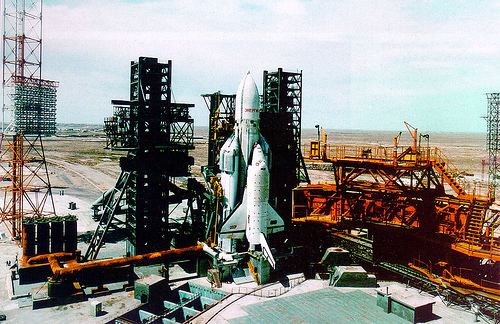 | ||
Function Crewed orbital launch and reentry Status Decommissioned; programme halted in 1993; 1K1 destroyed in a 2002 hangar collapse, 1K2 in storage in Baikonur; 2K1 at Zukhovsky Airport; 2 other orbiters barely started when programme was cancelled. Test articles in various exhibitions. Manufacturer S. P. Korolev Rocket and Space Corporation Energia | ||
The Buran (Russian: Бура́н, [bʊˈran], "Snowstorm" or "Blizzard") programme, also known as the VKK Space Orbiter (Russian: Воздушно Космический Корабль, "Air Space Ship") programme, was a Soviet and later Russian reusable spacecraft project that began in 1974 at the Central Aerohydrodynamic Institute and was formally suspended in 1993. In addition to being the designation for the whole Soviet/Russian reusable spacecraft project, Buran was also the name given to Orbiter K1, which completed one unmanned spaceflight in 1988 and was the only Soviet reusable spacecraft to be launched into space. The Buran-class space shuttle orbiters used the expendable Energia rocket as a launch vehicle. They are generally treated as a Soviet equivalent of the United States' Space Shuttle but in the Buran project, only the airplane-shaped orbiter itself was theoretically reusable, and while Orbiter K1 was recovered successfully after its first orbital flight in 1988, it was never reused.
Contents
- Introduction
- Background
- Programme development
- Flight crew preparation
- Spaceflight of I P Volk
- Spaceflight of A S Levchenko
- Ground facilities
- Missions
- Atmospheric test flights
- Orbital flight of Orbiter K1 in 1988
- Planned flights
- Cancellation of the programme 1993
- Baikonur hangar collapse
- Fleet status and locations
- Revival possibilities
- Specifications
- Comparison to NASAs Space Shuttle
- Key differences between Buran and NASAs Space Shuttle
- References
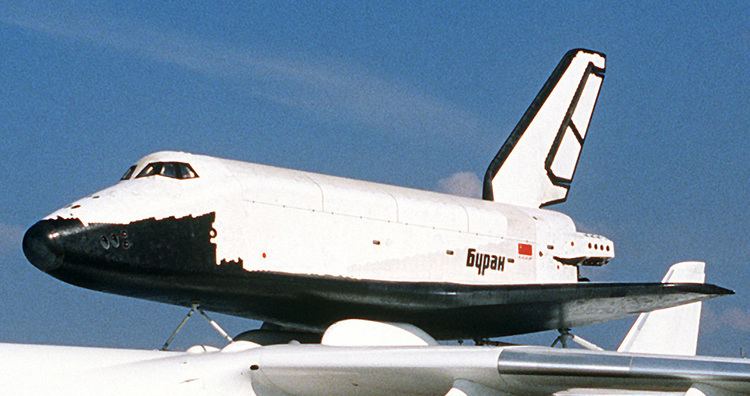
The Buran programme was started by the Soviet Union as a response to the United States Space Shuttle program. The project was the largest and the most expensive in the history of Soviet space exploration. Development work included sending BOR-5 test vehicles on multiple sub-orbital test flights, and atmospheric flights of the OK-GLI aerodynamic prototype. Buran completed one unmanned orbital spaceflight in 1988 before its cancellation in 1993. Orbiter K1, which flew the test flight in 1988 was crushed in a hangar collapse on 12 May 2002 in Kazakhstan. The OK-GLI resides in Technikmuseum Speyer. Although Soviet/Russian Buran spacecraft was similar in appearance to NASA's Space Shuttle, and could similarly operate as a re-entry spaceplane, its internal and functional design was distinct. For example, the main engines during launch were on the Energia rocket and were not taken into orbit by the spacecraft. Smaller rocket engines on the craft's body provided propulsion in orbit and de-orbital burns.

Introduction

The Buran orbital vehicle programme was developed in response to the U.S. Space Shuttle programme, which in the 1980s raised considerable concerns among the Soviet military and especially Defense Minister Dmitriy Ustinov. An authoritative chronicler of the Soviet and later Russian space programmes, the academic Boris Chertok, recounts how the programme came into being. According to Chertok, after the U.S. developed its Space Shuttle programme, the Soviet military became suspicious that it could be used for military purposes, due to its enormous payload, several times that of previous U.S. launch vehicles. The Soviet government asked the TsNIIMash (ЦНИИМАШ, Central Institute of Machine-building, a major player in defense analysis) for an expert opinion. Institute director, Yuri Mozzhorin, recalls that for a long time the institute could not envisage a civilian payload large enough to require a vehicle of that capacity.
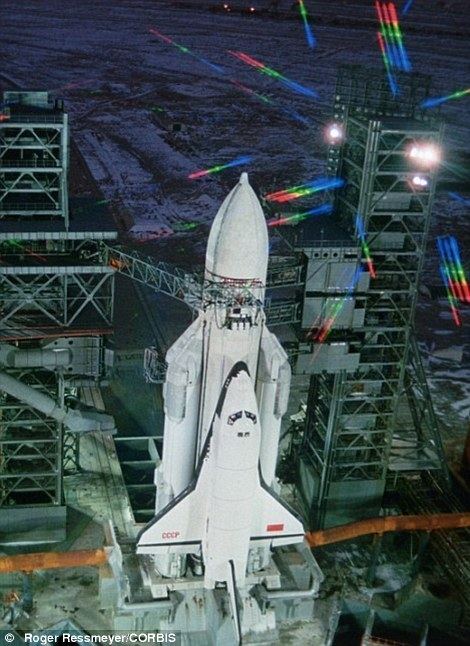
Officially, the Buran orbital vehicle was designed for the delivery to orbit and return to Earth of spacecraft, cosmonauts, and supplies. Both Chertok and Gleb Lozino-Lozinskiy (Chief Designer of RKK Energia) suggest that from the beginning, the programme was military in nature; however, the exact military capabilities, or intended capabilities, of the Buran programme remain classified. Commenting on the discontinuation of the programme in his interview to New Scientist, Russian cosmonaut Oleg Kotov confirms their accounts:
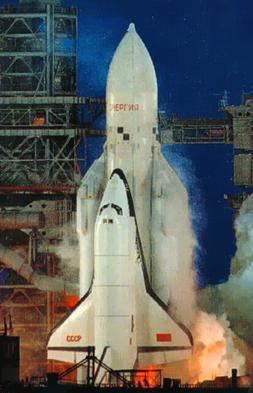
We had no civilian tasks for Buran and the military ones were no longer needed. It was originally designed as a military system for weapon delivery, maybe even nuclear weapons. The American shuttle also has military uses.
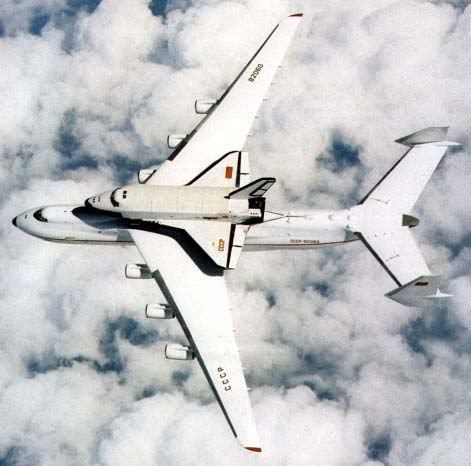
Like its American counterpart, the Buran orbital vehicle, when in transit from its landing sites back to the launch complex, was transported on the back of a large jet aeroplane — the Antonov An-225 Mriya transport aircraft, which was designed in part for this task and remains the largest aircraft in the world to fly multiple times.. Before the Mriya was ready (after the Buran had flown), the Myasishchev VM-T Atlant, a variant on the Soviet Myasishchev M-4 Molot (Hammer) bomber (NATO code: Bison), fulfilled the same role.
Background
The Soviet reusable space-craft programme has its roots in the very beginning of the space age, the late 1950s. The idea of Soviet reusable space flight is very old, though it was neither continuous, nor consistently organized. Before Buran, no project of the programme reached production.
The idea saw its first iteration in the Burya high-altitude jet aircraft, which reached the prototype stage. Several test flights are known, before it was cancelled by order of the Central Committee. The Burya had the goal of delivering a nuclear payload, presumably to the United States, and then returning to base. The cancellation was based on a final decision to develop ICBMs. The next iteration of the idea was Zvezda from the early 1960s, which also reached a prototype stage. Decades later, another project with the same name was used as a service module for the International Space Station. After Zvezda, there was a hiatus in reusable projects until Buran.
Programme development
The development of the Buran began in the early 1970s as a response to the U.S. Space Shuttle program. Soviet officials were concerned about a perceived military threat posed by the U.S. Space Shuttle. In their opinion, the Shuttle's 30-ton payload-to-orbit capacity and, more significantly, its 15-ton payload return capacity, were a clear indication that one of its main objectives would be to place massive experimental laser weapons into orbit that could destroy enemy missiles from a distance of several thousands of kilometers. Their reasoning was that such weapons could only be effectively tested in actual space conditions and that to cut their development time and save costs it would be necessary to regularly bring them back to Earth for modifications and fine-tuning. Soviet officials were also concerned that the U.S. Space Shuttle could make a sudden dive into the atmosphere to drop bombs on Moscow.
Soviet engineers were initially reluctant to design a spacecraft that looked superficially identical to the Shuttle, but subsequent wind tunnel testing showed that NASA's design was already ideal. Even though the Molniya Scientific Production Association proposed its Spiral programme design (halted 13 years earlier), it was rejected as being altogether dissimilar from the American shuttle design. While NPO Molniya conducted development under the lead of Gleb Lozino-Lozinskiy, the Soviet Union's Military-Industrial Commission, or VPK, was tasked with collecting all data it could on the U.S. Space Shuttle. Under the auspices of the KGB, the VPK was able to amass documentation on the American shuttle's airframe designs, design analysis software, materials, flight computer systems and propulsion systems. The KGB targeted many university research project documents and databases, including Caltech, MIT, Princeton, Stanford and others. The thoroughness of the acquisition of data was made much easier as the U.S. shuttle development was unclassified.
The construction of the shuttles began in 1980, and by 1984 the first full-scale Buran was rolled out. The first suborbital test flight of a scale-model (BOR-5) took place as early as July 1983. As the project progressed, five additional scale-model flights were performed. A test vehicle was constructed with four jet engines mounted at the rear; this vehicle is usually referred to as OK-GLI, or as the "Buran aerodynamic analogue". The jets were used to take off from a normal landing strip, and once it reached a designated point, the engines were cut and OK-GLI glided back to land. This provided invaluable information about the handling characteristics of the Buran design, and significantly differed from the carrier plane/air drop method used by the United States and the Enterprise test craft. Twenty-four test flights of OK-GLI were performed after which the shuttle was "worn out". The developers considered using a couple of Mil Mi-26 helicopters to "bundle" lift the Buran, but test flights with a mock-up showed how risky and impractical that was. The VM-T ferried components and the Antonov An-225 Mriya (the heaviest airplane ever) was designed and used to ferry the shuttle.
The flight and ground-testing software also required research. In 1983 the Buran developers estimated that the software development would require several thousand programmers if done with their existing methodology (in assembly language), and they appealed to Keldysh Institute of Applied Mathematics for assistance. It was decided to develop a new high-level "problem-oriented" programming language. Researchers at Keldysh developed two languages: PROL2 (used for real-time programming of onboard systems) and DIPOL (used for the ground-based test systems), as well as the development and debugging environment SAPO PROLOGUE. There was also an operating system known as Prolog Manager. Work on these languages continued beyond the end of the Buran project, with PROL2 being extended into SIPROL, and eventually all three languages developed into DRAKON which is still in use in the Russian space industry. A declassified May 1990 CIA report citing open-source intelligence material states that the software for the Buran spacecraft was written in "the French-developed programming language known as Prolog", possibly due to confusion with the name PROLOGUE.
Flight crew preparation
Until the end of the Soviet Union in 1991, seven cosmonauts were allocated to the Buran programme and trained on the OK-GLI ("Buran aerodynamic analogue") test vehicle. All had experience as test pilots. They were: Ivan Ivanovich Bachurin, Alexei Sergeyevich Borodai, Anatoli Semyonovich Levchenko, Aleksandr Vladimirovich Shchukin, Rimantas Antanas Stankevičius, Igor Petrovich Volk and Viktor Vasiliyevich Zabolotsky.
A rule, set in place for cosmonauts because of the failed Soyuz 25 of 1977, insisted that all Soviet space missions contain at least one crew member who has been to space before. In 1982, it was decided that all Buran commanders and their back-ups would occupy the third seat on a Soyuz mission, prior to their Buran spaceflight. Several people had been selected to potentially be in the first Buran crew. By 1985, it was decided that at least one of the two crew members would be a test pilot trained at the Gromov Flight Research Institute (known as "LII"), and potential crew lists were drawn up. Only two potential Buran crew members reached space: Igor Volk, who flew in Soyuz T-12 to the space station Salyut 7, and Anatoli Levchenko who visited Mir, launching with Soyuz TM-4 and landing with Soyuz TM-3. Both of these spaceflights lasted about a week.
Levchenko died of a brain tumour the year after his orbital flight, Bachurin left the cosmonaut corps because of medical reasons, Shchukin was assigned to the back-up crew of Soyuz TM-4 and later died in a plane crash, Stankevičius was also killed in a plane crash, while Borodai and Zabolotsky remained unassigned to a Soyuz flight until the Buran programme ended.
Spaceflight of I. P. Volk
Igor Volk was planned to be the commander of the first manned Buran flight. There were two purposes of the Soyuz T-12 mission, one of which was to give Volk spaceflight experience. The other purpose, seen as the more important factor, was to beat the United States and have the first spacewalk by a woman. At the time of the Soyuz T-12 mission the Buran programme was still a state secret. The appearance of Volk as a crew member caused some, including the British Interplanetary Society magazine Spaceflight, to ask why a test pilot was occupying a Soyuz seat usually reserved for researchers or foreign cosmonauts.
Spaceflight of A. S. Levchenko
Anatoli Levchenko was planned to be the back-up commander of the first manned Buran flight, and in March 1987 he began extensive training for his Soyuz spaceflight. In December 1987, he occupied the third seat aboard Soyuz TM-4 to Mir, and returned to Earth about a week later on Soyuz TM-3. His mission is sometimes called Mir LII-1, after the Gromov Flight Research Institute shorthand. When Levchenko died the following year, it left the back-up crew of the first Buran mission again without spaceflight experience. A Soyuz spaceflight for another potential back-up commander was sought by the Gromov Flight Research Institute, but never occurred.
Ground facilities
Maintenance, launches and landings of the Buran-class orbiters were to take place at the Baikonur Cosmodrome in the Kazakh S.S.R. Several facilities at Baikonur were adapted or newly built for these purposes:
Missions
Following a series of atmospheric test flights using the jet-powered OK-GLI prototype, the first operational spacecraft (Orbiter K1) flew one test mission on 15 November 1988 at 03:00:02 UTC. The spacecraft was launched unmanned from and landed at Baikonur Cosmodrome in the Kazakh S.S.R. and flew two orbits, travelling 83,707 kilometres (52,013 mi) in 3 hours and 25 minutes (0.14 flight days). Buran never flew again; the programme was cancelled shortly after the dissolution of the Soviet Union. In 2002, the collapse of the hangar in which it was stored destroyed the Buran orbiter.
Atmospheric test flights
An aerodynamic testbed, OK-GLI, was constructed in 1984 to test the in-flight properties of the Buran design. Unlike the American prototype Space Shuttle Enterprise, OK-GLI had four AL-31 turbofan engines fitted, meaning it was able to fly under its own power.
Orbital flight of Orbiter K1 in 1988
The only orbital launch of the Orbiter K1 Buran (also known as ""OK-1K1" or "Shuttle 1.01") was at 3:00 UTC on 15 November 1988 from pad 110/37 in Baikonur. The unmanned craft was lifted into orbit by the specially designed Energia booster rocket. The life support system was not installed and no software was installed on the CRT displays. The shuttle orbited the Earth twice in 206 minutes of flight. On its return, it performed an automated landing on the shuttle runway at Baikonur Cosmodrome.
Planned flights
The planned flights for the shuttles in 1989, before the downsizing of the project and eventual cancellation, were:
The planned unmanned second flight of Ptichka was changed in 1991 to the following:
Cancellation of the programme 1993
After the first flight of a Buran shuttle, the project was suspended due to lack of funds and the political situation in the Soviet Union. The two subsequent orbiters, which were due in 1990 (informally Ptichka) and 1992 (informally Baikal) were never completed. The project was officially terminated on 30 June 1993, by President Boris Yeltsin. At the time of its cancellation, 20 billion rubles (roughly US$71,534,000) had been spent on the Buran programme.
The programme was designed to boost national pride, carry out research, and meet technological objectives similar to those of the U.S. Space Shuttle programme, including resupply of the Mir space station, which was launched in 1986 and remained in service until 2001. When Mir was finally visited by a space shuttle, the visitor was a U.S. Shuttle, not Buran.
The Buran SO, a docking module that was to be used for rendezvous with the Mir space station, was refitted for use with the U.S. Space Shuttles during the Shuttle–Mir missions.
Baikonur hangar collapse
On 12 May 2002, a hangar roof at the Baikonur Cosmodrome in Kazakhstan collapsed because of a structural failure due to poor maintenance. The collapse killed 8 workers and destroyed one of the Buran craft (Orbiter K1), as well as a mock-up of an Energia booster rocket. It was not clear to outsiders at the time which Buran programme craft was destroyed, and the BBC reported that it was just "a model" of the orbiter. It occurred at the MIK RN/MIK 112 building at Site 112 of the Baikonur Cosmodrome, 14 years after the first and only Buran flight. Work on the roof had begun for a maintenance project, whose equipment is thought to have contributed to the collapse. Also, before the day of collapse, there had been several days of heavy rain.
Fleet status and locations
Most of the geo-location below show the shuttle bodies on the ground; in some cases Google Earth's History facility is required to see the shuttle within the dates specified.
Revival possibilities
Over time, several scientists looked into trying to revive the Buran programme, especially after the Space Shuttle Columbia disaster.
The 2003 grounding of the U.S. Space Shuttles caused many to wonder whether the Russian Energia launcher or Buran shuttle could be brought back into service. By then, however, all of the equipment for both (including the vehicles themselves) had fallen into disrepair or been repurposed after falling into disuse with the collapse of the Soviet Union.
In 2010 the director of Moscow's Central Machine Building Institute said the Buran project would be reviewed in the hope of restarting a similar manned spacecraft design, with rocket test launches as soon as 2015. Russia also continues work on the PPTS but has abandoned the Kliper program, due to differences in vision with its European partners.
Due to the 2011 retirement of the American Space Shuttle and the need for STS-type craft in the meantime to complete the International Space Station, some American and Russian scientists had been mulling over plans to possibly revive the already-existing Buran shuttles in the Buran programme rather than spend money on an entirely new craft and wait for it to be fully developed but the plans did not come to fruition.
On the 25th anniversary of the Buran flight in November 2013, Oleg Ostapenko, the new head of Roscosmos, the Russian Federal Space Agency, proposed that a new heavy lift launch vehicle be built for the Russian space program. The rocket would be intended to place a payload of 100 tonnes (220,000 lb) in a baseline low Earth orbit and is projected to be based on the Angara launch vehicle technology.
Recently there have been new interests in renewing the programme temporarily while Russia struggles with the CSTS and Kliper design stages.
Specifications
Unlike the US Space Shuttle, which was propelled by a combination of solid boosters and the shuttle orbiter's own liquid-fuel engines fueled from a large fuel tank, the Soviet/Russian shuttle system used thrust from the rocket's four RD-170 liquid oxygen/kerosene engines developed by Valentin Glushko and another four RD-0120 liquid oxygen/liquid hydrogen engines.
Comparison to NASA's Space Shuttle
Because Buran's debut followed that of Space Shuttle Columbia's, and because there were striking visual similarities between the two shuttle systems—a state of affairs which recalled the similarity between the Tupolev Tu-144 and Concorde supersonic airliners—many speculated that Cold War espionage played a role in the development of the Soviet shuttle. Despite remarkable external similarities, many key differences existed, which suggests that, had espionage been a factor in Buran's development, it would likely have been in the form of external photography or early airframe designs. One CIA commenter states that Buran was based on a rejected NASA design. See the § Programme development section above.
